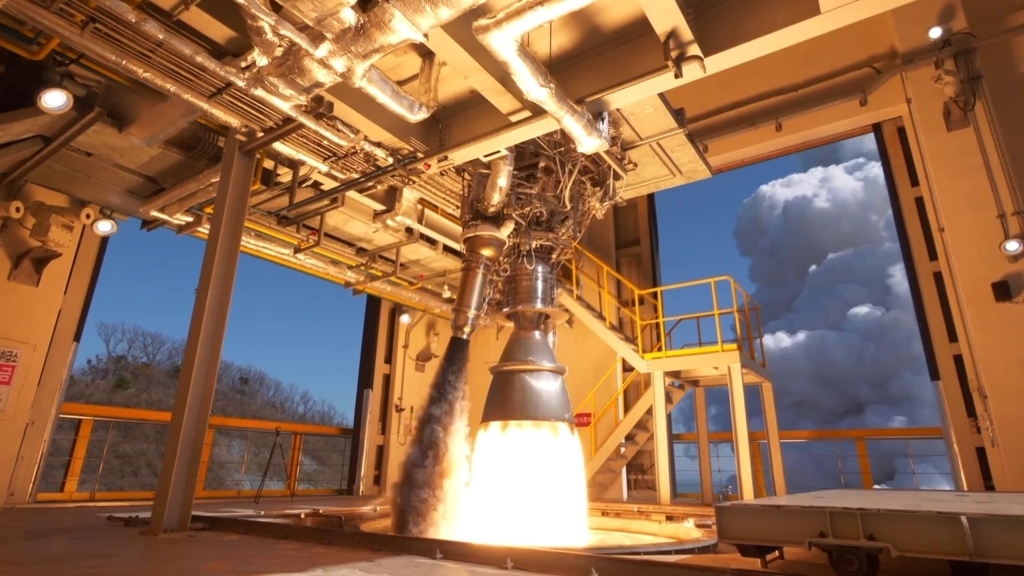[News Analysis] Fettered for decades, Seoul to strengthen space push
By Choi Si-youngPublished : July 29, 2020 - 15:42

With a major hurdle lifted on rocket propellants, South Korea is set to double up its efforts to build a foothold in space, eyeing, above anything else, the country’s first ship to land on the moon and its first spy satellite, experts said Wednesday.
President Moon Jae-in, addressing the revision in a Korea-US missile pact announced the previous day, signaled a push to secure “complete missile sovereignty,” while expressing hopes to see industries affected by the latest change to provide growth momentum for the economy.
“It is an opportunity for the country to benefit from space technologies as a next-generation industry,” he said.
Under the revised missile guidelines between Seoul and Washington, South Korea can now launch long-range rockets based on solid propellants, as well as liquid and hybrid propellants.
The Korea-US agreement, first signed in 1979 and revised three times, put restrictions on the use of solid-fuel engines, which effectively thwarted the country’s advances toward space.
Relying on liquid-fuel engines for every space launch, Korea has long sought to add solid-fuel engines as “boosters” to its space launch vehicles – wholly supported by liquid-fueled engines – to reach high orbit.
“The latest news tells us this: We could potentially see our ship landing on the moon, helped by a new set of solid-engine boosters,” said Ko Jeong-hwan, director at the Korea Aerospace Research Institute in charge of running the country’s space vehicles.
Korea expects to send a landing ship to the moon by 2030 and lunar orbiter in late 2022, according to Ko, who also oversees Korea’s first locally developed Korea Space Launch Vehicle-II set for its first flight in 2021.
Sending a ship to the moon depends on a combination of solid-fuel and liquid-fuel engines or much-advanced liquid-fuel engines alone, Ko said.
“But everything depends on how we come to draft a final road map first for the moon project. It’s a huge plan of great magnitude to pan out,” Ko said, adding the latest change would not affect the scheduled launch of the wholly liquid-fueled KSLV-II.
The latest relaxation could easily pave the way for the country to launch its first spy satellite, according to Moon’s deputy national security adviser Kim Hyun-chong. He steered the missile negotiations with the US.
“Our neighboring countries have several spy satellites hovering around us but we have none. We need our own too,” Kim said.
Solid-fuel engines are cheaper and quicker in launching projectiles than liquid-fuel engines, which means secretly launching a spy satellite into space requires the former. Washington has been reluctant to give that advantage to Seoul until now, according to a military official.
“Soon we will be sending our own low-altitude reconnaissance satellites. We have enough expertise already,” the military official said.
Experts said the US has given Korea a tactical upper hand in space exploration because that is in line with US national security interests.
“With an increasingly belligerent China and a stubborn nuclear-armed North Korea, the US sees that it could support its containment campaign through allies, us, by giving us greater flexibility to deter their aggression,” said Ryu Seong-yeop, an intelligence analyst at the Korea Research Institute for Military Affairs.
Ryu noted Washington was moving strategically, and that Seoul should not sit idle and squander away an opportunity to strengthen space technologies and expand its presence out there.
By Choi Si-young (siyoungchoi@heraldcorp.com)
President Moon Jae-in, addressing the revision in a Korea-US missile pact announced the previous day, signaled a push to secure “complete missile sovereignty,” while expressing hopes to see industries affected by the latest change to provide growth momentum for the economy.
“It is an opportunity for the country to benefit from space technologies as a next-generation industry,” he said.
Under the revised missile guidelines between Seoul and Washington, South Korea can now launch long-range rockets based on solid propellants, as well as liquid and hybrid propellants.
The Korea-US agreement, first signed in 1979 and revised three times, put restrictions on the use of solid-fuel engines, which effectively thwarted the country’s advances toward space.
Relying on liquid-fuel engines for every space launch, Korea has long sought to add solid-fuel engines as “boosters” to its space launch vehicles – wholly supported by liquid-fueled engines – to reach high orbit.
“The latest news tells us this: We could potentially see our ship landing on the moon, helped by a new set of solid-engine boosters,” said Ko Jeong-hwan, director at the Korea Aerospace Research Institute in charge of running the country’s space vehicles.
Korea expects to send a landing ship to the moon by 2030 and lunar orbiter in late 2022, according to Ko, who also oversees Korea’s first locally developed Korea Space Launch Vehicle-II set for its first flight in 2021.
Sending a ship to the moon depends on a combination of solid-fuel and liquid-fuel engines or much-advanced liquid-fuel engines alone, Ko said.
“But everything depends on how we come to draft a final road map first for the moon project. It’s a huge plan of great magnitude to pan out,” Ko said, adding the latest change would not affect the scheduled launch of the wholly liquid-fueled KSLV-II.
The latest relaxation could easily pave the way for the country to launch its first spy satellite, according to Moon’s deputy national security adviser Kim Hyun-chong. He steered the missile negotiations with the US.
“Our neighboring countries have several spy satellites hovering around us but we have none. We need our own too,” Kim said.
Solid-fuel engines are cheaper and quicker in launching projectiles than liquid-fuel engines, which means secretly launching a spy satellite into space requires the former. Washington has been reluctant to give that advantage to Seoul until now, according to a military official.
“Soon we will be sending our own low-altitude reconnaissance satellites. We have enough expertise already,” the military official said.
Experts said the US has given Korea a tactical upper hand in space exploration because that is in line with US national security interests.
“With an increasingly belligerent China and a stubborn nuclear-armed North Korea, the US sees that it could support its containment campaign through allies, us, by giving us greater flexibility to deter their aggression,” said Ryu Seong-yeop, an intelligence analyst at the Korea Research Institute for Military Affairs.
Ryu noted Washington was moving strategically, and that Seoul should not sit idle and squander away an opportunity to strengthen space technologies and expand its presence out there.
By Choi Si-young (siyoungchoi@heraldcorp.com)








![[Graphic News] More Koreans say they plan long-distance trips this year](http://res.heraldm.com/phpwas/restmb_idxmake.php?idx=644&simg=/content/image/2024/04/17/20240417050828_0.gif&u=)
![[KH Explains] Hyundai's full hybrid edge to pay off amid slow transition to pure EVs](http://res.heraldm.com/phpwas/restmb_idxmake.php?idx=644&simg=/content/image/2024/04/18/20240418050645_0.jpg&u=20240419100350)






![[From the Scene] Monks, Buddhists hail return of remains of Buddhas](http://res.heraldm.com/phpwas/restmb_idxmake.php?idx=652&simg=/content/image/2024/04/19/20240419050617_0.jpg&u=20240419175937)

![[KH Explains] Hyundai's full hybrid edge to pay off amid slow transition to pure EVs](http://res.heraldm.com/phpwas/restmb_idxmake.php?idx=652&simg=/content/image/2024/04/18/20240418050645_0.jpg&u=20240419100350)

![[Today’s K-pop] Illit drops debut single remix](http://res.heraldm.com/phpwas/restmb_idxmake.php?idx=642&simg=/content/image/2024/04/19/20240419050612_0.jpg&u=)